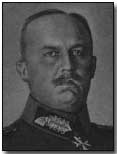Who's Who - Erich Ludendorff
 Erich Ludendorff
(1865-1937) was born near Poznan on 9 April 1865.
Erich Ludendorff
(1865-1937) was born near Poznan on 9 April 1865.
Commissioned into the infantry in 1883 and a member of the General Staff from 1894, Ludendorff served as head of the deployment section in 1908. A highly militaristic man, Ludendorff held that peace was merely the interval between wars, and that the nation's chief duty was to provide the means with which to conduct war. In the pre-war period Ludendorff assisted with the fine-tuning of the invasion strategy for France, the Schlieffen Plan.
Upon the outbreak of the First World War he was made quartermaster general to von Bulow's Second Army, responsible for capturing the Liege forts, without which the Schlieffen Plan could not succeed. This task successfully accomplished, Ludendorff was sent to East Prussia where he worked with Paul von Hindenburg as his Chief of Staff.
Hindenburg, who relied heavily upon Ludendorff in crafting his victories at Tannenberg (1914) and the Masurian Lakes (1915), later appointed Ludendorff his quartermaster general when he was appointed Chief of Staff of the German Army in late August 1916, replacing Erich Falkenhayn.
Shortly after becoming Chief of Staff, Hindenburg, working with Ludendorff and leading industrialists, created what was effectively a military-industrial dictatorship, the Third Supreme Command, largely relegating the Kaiser, Wilhelm II, to a peripheral role. Ludendorff was the chief engineer behind the management of the German war effort during this time, with Hindenburg his pliant front man.
Ludendorff was a supporter of unrestricted submarine warfare, an especially controversial policy with the then-neutral Americans, ultimately responsible for bringing the U.S. into the war. An aggressive commander, Ludendorff pressured the Kaiser to dismiss those in the armed forces who favoured a negotiated peace settlement; Wilhelm agreed, with Chancellor Bethmann-Hollweg a casualty of Ludendorff's 'defeatist' campaign.
With Russia's withdrawal from the war in 1917, Ludendorff played a key role in the Brest-Litovsk peace treaty, an agreement negotiated at great cost to Russia.
Expecting a successful resolution to the great German spring push in 1918, Ludendorff realised that the war was lost once the offensive failed, aware that with the arrival of fresh American troops the impetus would quickly swing to the Allies. He therefore, with Hindenburg, transferred power back to the Reichstag on 29 September, demanding an immediate peace; subsequently changing his mind, Ludendorff was forced to resign on 26 October under pressure from Max von Baden's government.
With the armistice Ludendorff left Germany for Sweden. Whilst in exile he wrote numerous books and articles mythologizing the German military's conduct of the war, claiming that the army had been 'stabbed in the back' by Germany's left-wing political element.
Ludendorff eventually returned to Germany in 1920, where as a right-wing politician he took part in the Hitler Munich Putsch of 9 November 1923. In 1924 he was elected to the Reichstag as a representative of the Nazi party, serving until 1928. He contested the 1925 presidential election against his former commander, Paul von Hindenburg, the latter easily winning.
Erich Ludendorff died on 20 December 1937 at the age of 72. Hitler attended his funeral.
Click here and here to read Ludendorff's view of the Verdun offensive. Click here to read his reaction to news that the French Army's offensive on the Aisne and at Champagne had failed, in April 1917. Click here to read Ludendorff's account of German losses at Third Ypres. Click here to read Ludendorff's official report on the opening of the Spring Offensive of March 1918. Click here and here to read Ludendorff's contrasting views on the effective of the Allied counterattacks at the Second Battle of the Marne. Click here to read Ludendorff's post-war account of the Meuse-Argonne Offensive.
To view film footage of Ludendorff click here; and here; and here.
In preparation for the Battle of the Somme, the British launched a seven-day artillery bombardment in which 1,500 guns fired 1.6 million rounds.
- Did you know?
